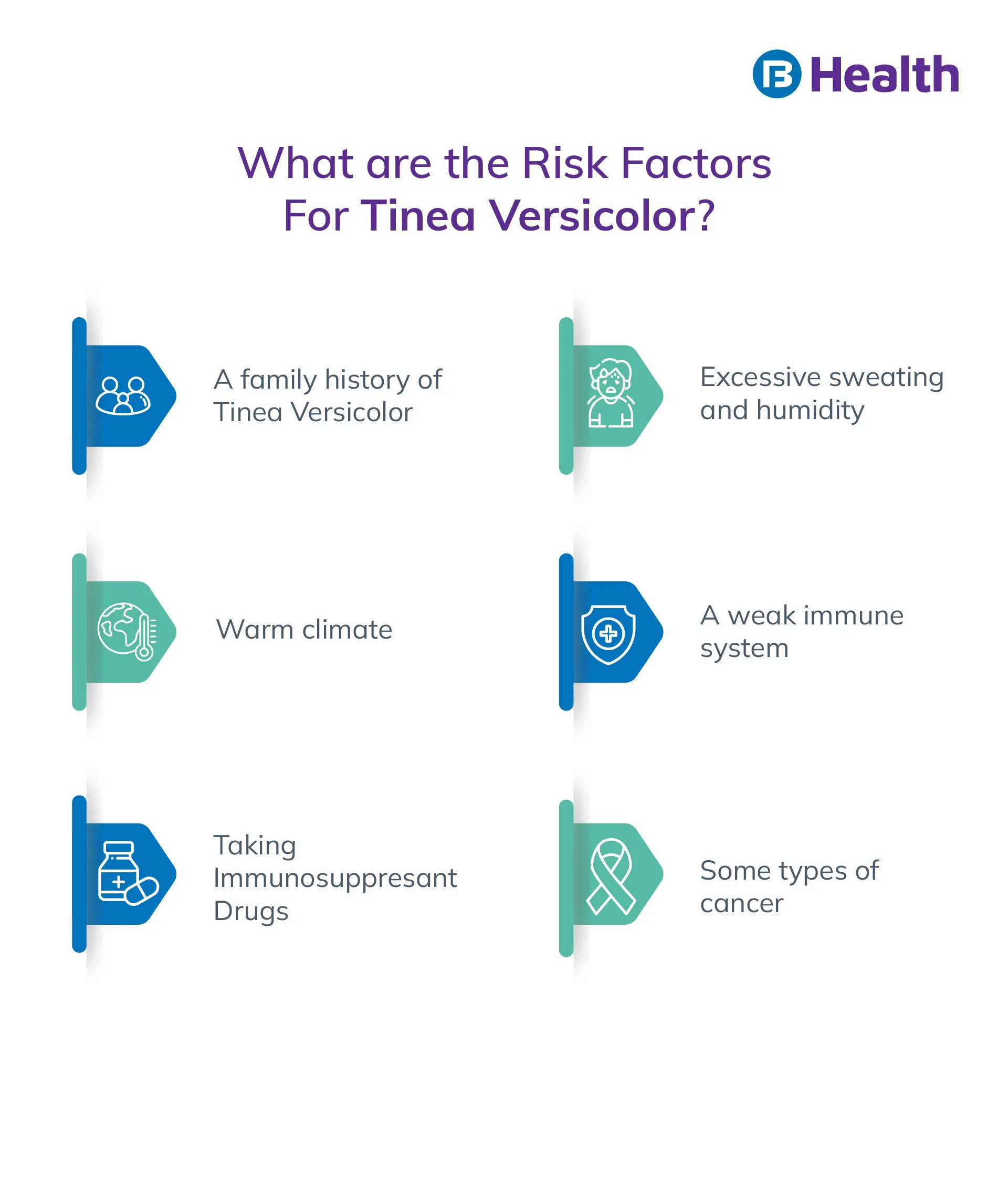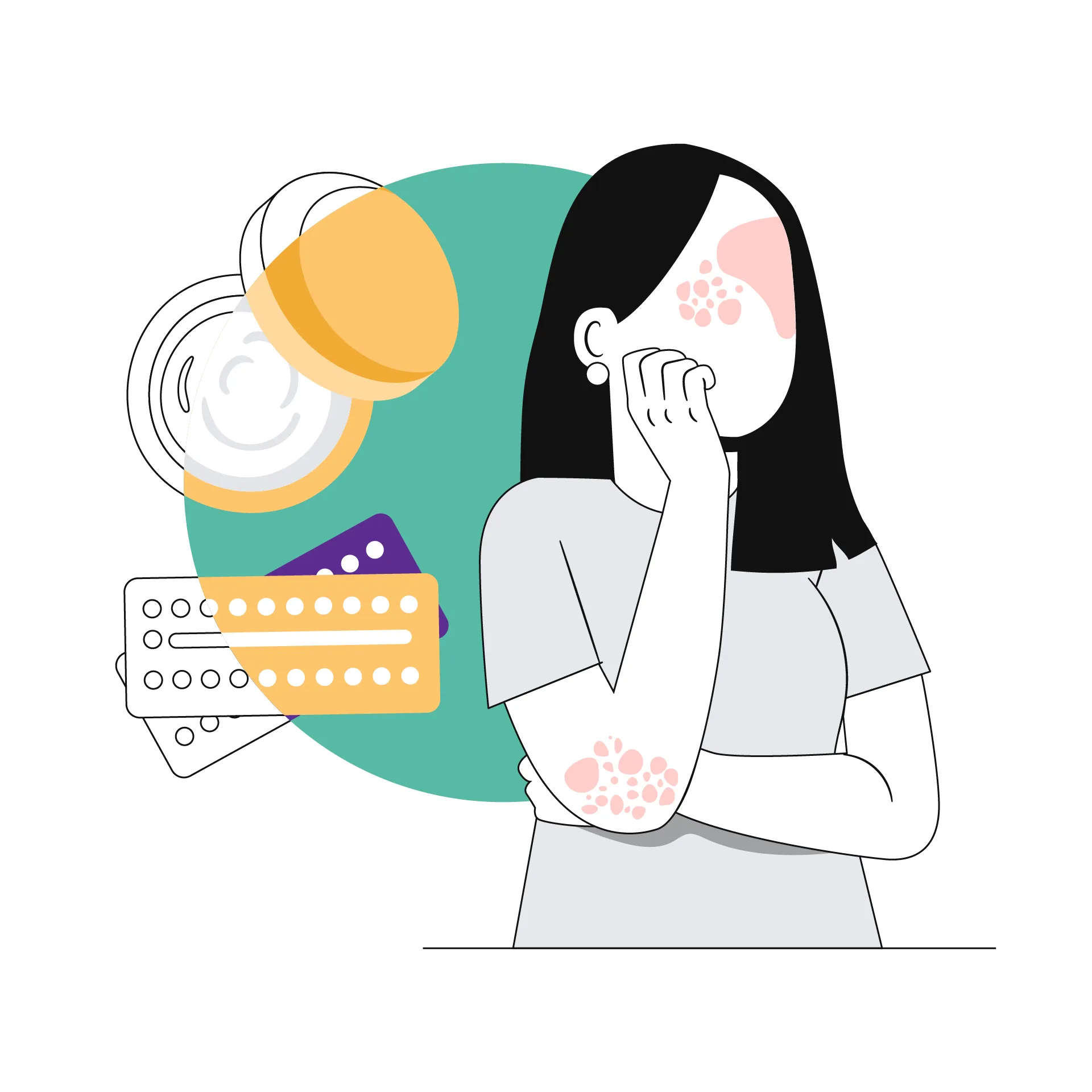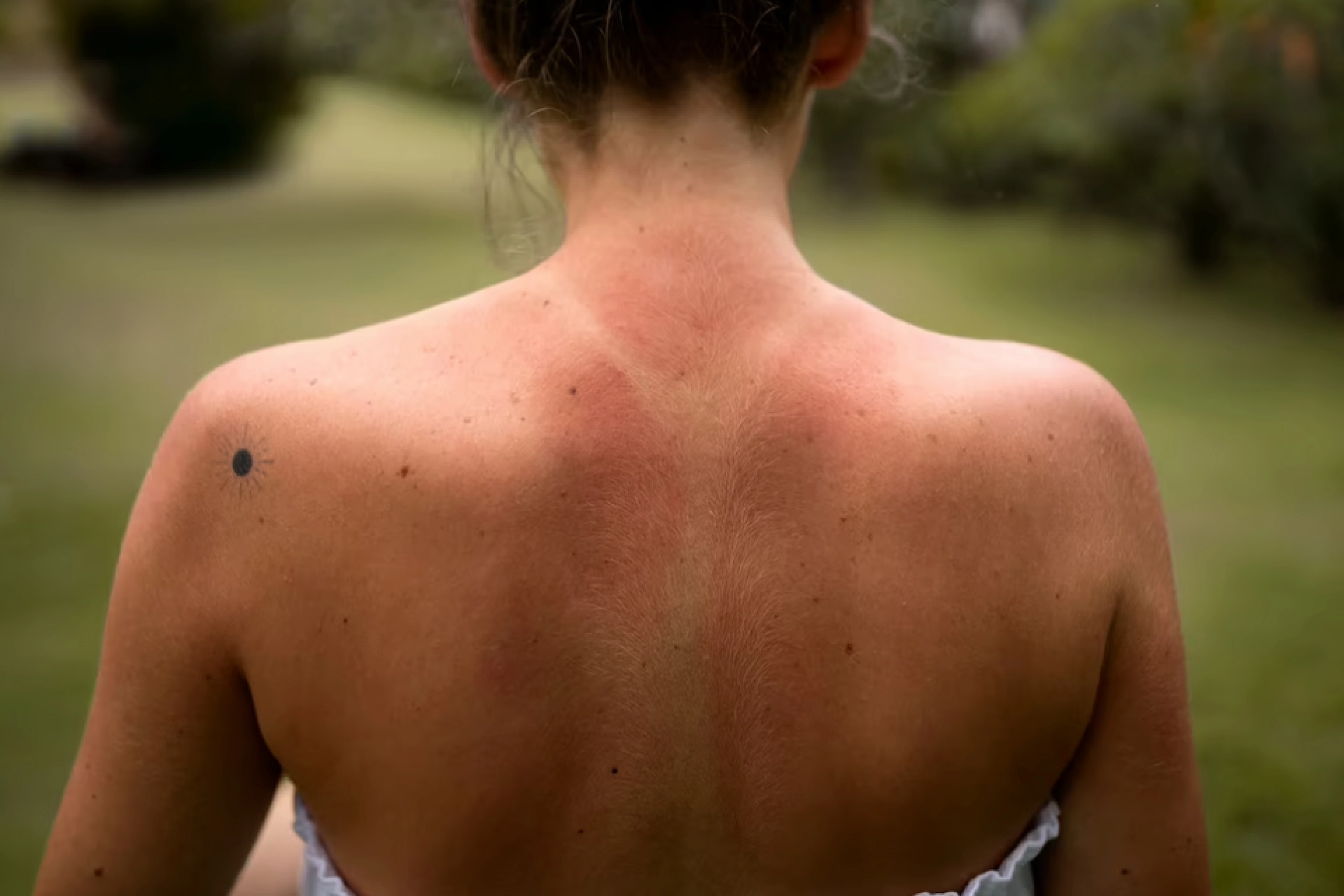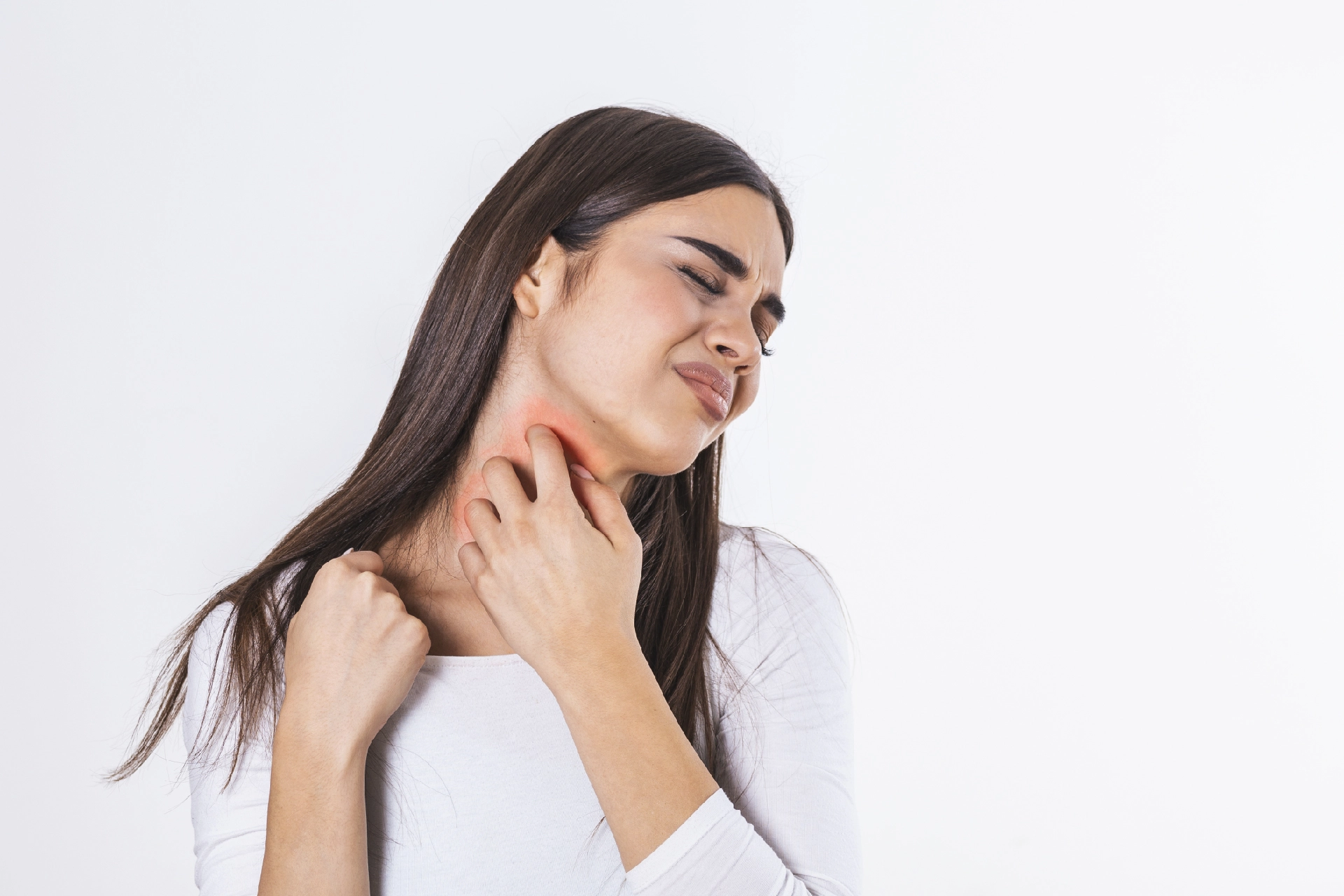Physical Medicine and Rehabilitation | 7 min read
Tinea Versicolor: Causes, Risk Factor and Diagnosis
Medically reviewed by
Table of Content
Synopsis
Tinea versicolor the most common skin infections. That appears on the trunk and shoulders
.
Key Takeaways
- Tinea versicolor is a fungal skin infection
- Discoloration and patches are formed on the chest or back
- It is more common in adolescence and early adulthood due to oily skin
One of the most prevalent skin infections in tropical and subtropical regions of the world is tinea versicolor, now known as pityriasis Versicolor. [1] The usual skin pigmentation is disturbed by this widespread fungal infection. Small areas of skin that may be lighter or darker in hue than the surrounding skin result from this. The trunk and shoulders are where tinea versicolor most frequently appears on people.
Although the infection is not harmful or communicable, persons who have it may feel self-conscious. Hence, it can cause emotional distress or self-consciousness.
Causes of Tinea versicolor
Tinea versicolor is caused by a superficial yeast overgrowth called Malassezia. A combination of environmental and biological factors can cause this overgrowth.
Some of the factors that may promote the growth of this yeast on the skin are as follows:
- Excessive sweating
- Hormonal changes
- A weak immune system
- Humid and Hot Weather
- Oily skin
Tinea versicolor can affect people of all ethnicities, but it most often affects adolescents. Adults who visit a subtropical climate are more likely to develop tinea versicolor.[2]
Additional Read: Ultimate Skincare Guide For Men With Oily Skin
Risk Factors for Tinea versicolor
Here are some biological and environmental factors that can increase your chances of developing this condition:
- A family history of tinea versicolor
- Excessive sweating
- A weak immune system
- Taking immune-suppressing medications
- Some types of cancer
When to Visit a Dermatologist
You have to visit a dermatologist if you see any of the given symptoms:
- Self-care measures do not improve your skin.
- The fungal infection reappears.
- The patches cover large areas of your body.
Symptoms of Tinea versicolor
- Tinea versicolor is characterized by numerous tan, brown, salmon, or white scaly patches on the trunk, neck, abdomen, and, in rare cases, the face.
- The patches can be joined together to form larger patches. Because the patches do not tan, they may become visible in the summer when the surrounding skin tans.
- Lighter patches may appear on people who have naturally dark skin. This is referred to as hypopigmentation. People with fair skin may develop darker or lighter patches. This is referred to as hyperpigmentation. Tinea versicolor rarely causes other symptoms.
- Only when spots appear on the skin is a person likely to notice tinea versicolor. These spots can be lighter or darker than the surrounding skin and are frequently more visible when the surrounding skin is tanned.
- Though these spots are most common around the trunk and neck, they can appear anywhere on the body.
Additional symptoms may include:
- Itchy Spotshy (mild itching).
- Spots that grow slowly over time and may eventually form patches.
- Only the top layers of the skin are infected.
- The rash is typically found on the trunk but not on the face.
- Summer patches.
- Affected areas that do not darken when exposed to sunlight.
Symptoms may disappear or diminish in cooler weather, only to reappear when the weather becomes hot and humid.
Additional read: How to Reduce Skin Rashes
Similar Conditions
- Some overlapping symptoms, such as vitiligo, are frequently confused with tinea versicolor. However, vitiligo differs from tinea versicolor in several ways, including:
- Vitiligo does not affect the texture of your skin.
- Vitiligo commonly affects the fingers, wrists, armpits, eyes, mouth, and groin.
- Vitiligo frequently causes symmetrical patches.
- Pityriasis rosea rash is similar to tinea versicolor rash. Still, it is usually preceded by a "herald patch," a solitary red scaly patch that appears a few days or weeks before the rash. This rash usually appears on the back in the shape of a Christmas tree. This condition's cause is unknown. However, it is neither harmful nor contagious, as is tinea versicolor.
- eczema is an auto-immune disease, unlike tinea versicolor which is caused by a fungal infection. It also results in red itchy rashes appearing on the skin.
- Skin tags are small non-cancerous skin growths, they are most of the time harmless and skin tag removal can help get rid of them
Treatment of Tinea versicolor
There are numerous treatment options for tinea versicolor. What a doctor uses to treat tinea versicolor is determined by factors such as the climate, the area infected, the thickness of the infection, and where the infection appears on the body.
Your doctor will determine the best treatment for tinea versicolor based on the following factors:
- Age, general health, and medical history
- The severity of the condition
- Tolerance of particular treatments, procedures, or drugs
- Expectations for the condition's progression
- Your point of view or preference
The following are the most popular types of treatment:
- Selenium sulfide, ketoconazole, or pyrithione zinc creams and lotions:
- Medicated shampoos and body washes for use when flares are expected, such as during extremely hot and humid weather.
- When large areas of the body are infected, oral antifungal medication is used.
Clear Description of the Treatment Options:
- Tinea versicolor can be treated with any antifungal medication applied directly to the affected areas (topical).
- Selenium sulfide shampoo is effective when applied to affected skin (not just the scalp) for 10 minutes every day for one week or once every week for one month.
- Fluconazole and other antifungal drugs are taken orally and sometimes used to treat people with widespread infection.
- Other treatments include applying topical ketoconazole to the skin every day for two weeks, bathing with zinc pyrithione soap, and using sulfur-salicylic shampoo on the skin every day for one to two weeks.
- Many doctors recommend practicing proper hygiene and using zinc pyrithione soap or other topical treatments every month to reduce the chances of the infection returning.
It is critical that people follow all instructions on how to use the medication. Failure to use the entire amount or inconsistency in usage may cause the infection to resurface quickly.
Diagnosis of Tinea versicolor
- Skin scrapings and a doctor's examination of the skin: Your doctor may take a skin scraping if a diagnosis cannot be made by looking at the skin. A skin scraping gently scrapes your skin to remove cells for testing. Doctors diagnose tinea versicolor by examining skin scrapings under a microscope to see if the fungus is present.
- A Wood light examination: Doctors may use an ultraviolet light (known as a Wood light) to more clearly show the infection on the skin.
- Potassium hydroxide (KOH) microscopy: In this procedure, your doctor takes a skin sample, places it on a microscope slide with a 20% KOH solution, and examines it for yeast or fungi under a microscope.
- A biopsy: or tissue sample, of the affected skin may also be taken and tested for fungi on the outer skin layer. To determine whether you have the condition, a sample of the fungus on your skin can be tested in a fungal culture.
Tinea Versicolor Prognosis
The skin's pigmentation may not return to normal for months or years after the infection has cleared. Tinea versicolor frequently recurs after successful treatment because the yeast that causes it lives on the skin.
Versicolor Prognosis Home remedies
Tinea versicolor can be avoided and managed with a few home remedies and lifestyle changes. The most important thing you can do to prevent a tinea versicolor infection is to keep your skin clean and oil-free.
Over-the-counter lotions and creams can aid in the prevention and treatment of minor flare-ups. Examples of products include:
- Clotrimazole lotion or cream
- Terbinafine gel or creamski
- Miconazole ointment
- 1 percent selenium sulfide lotion
- Soap containing zinc pyrithione
- Exfoliate skin to get rid of infected skin layer
It is also important to keep the skin covered and to avoid prolonged exposure to ultraviolet light. This includes UV light emitted by being outside and using a tanning bed.
Additional Read: Fungal Skin InfectionsPrevention of Tinea versicolor
- Hygiene is the most effective method of prevention. Removing excess oils and dirt from the skin can help protect against this infection.
- Over-the-counter antifungal lotions and shampoos are effective preventative measures. These same products can also aid in the treatment of a minor infection.
- You can also prevent tinea versicolor by using a prescription skin treatment during the seasons when you're most vulnerable.
- Additionally, taking extra precautions to stay dry in hot and humid weather and avoiding excessive sun exposure may aid in the prevention of tinea versicolor growth.
People who contract tinea versicolor have a very good prognosis. It is not painful in general, only mildly itchy, and is not contagious. Despite being generally responsive to treatment, it is a recurrent infection that is difficult to control completely.
If you have more queries, get an online doctor consultation in a click on Bajaj Finserv Health. The best thing here is that you can book a teleconsultation with a dermatologist from the comfort of your home and get all the advice you need. With the convenience and safety this offers, you can start taking the best care of your skin!
References
- https://www.ncbi.nlm.nih.gov/books/NBK11733/
- https://www.skinandcancerinstitute.com/everything-you-need-to-know-about-tinea-versicolor/
Disclaimer
Please note that this article is solely meant for informational purposes and Bajaj Finserv Health Limited (“BFHL”) does not shoulder any responsibility of the views/advice/information expressed/given by the writer/reviewer/originator. This article should not be considered as a substitute for any medical advice, diagnosis or treatment. Always consult with your trusted physician/qualified healthcare professional to evaluate your medical condition. The above article has been reviewed by a qualified doctor and BFHL is not responsible for any damages for any information or services provided by any third party.




